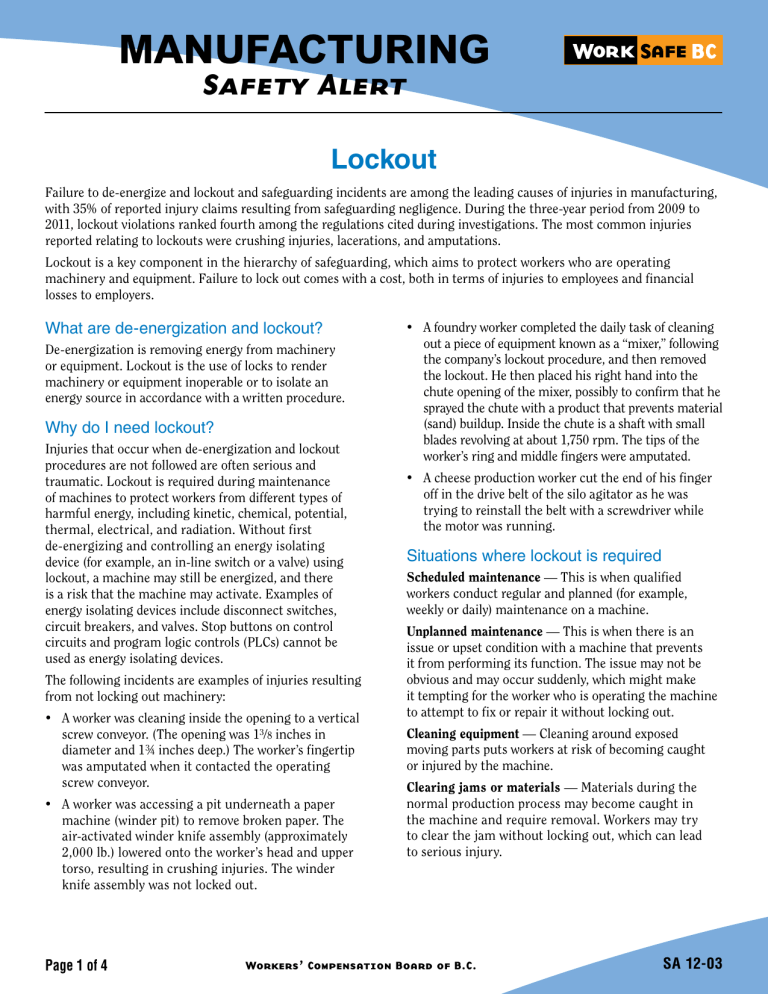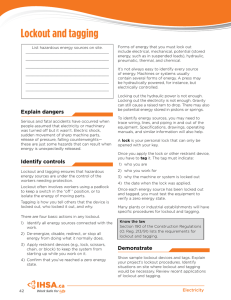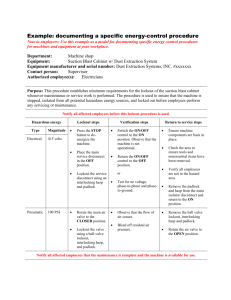Lockout - WorkSafeBC

Lockout
Failure to de-energize and lockout and safeguarding incidents are among the leading causes of injuries in manufacturing, with 35% of reported injury claims resulting from safeguarding negligence. During the three-year period from 2009 to
2011, lockout violations ranked fourth among the regulations cited during investigations. The most common injuries reported relating to lockouts were crushing injuries, lacerations, and amputations.
Lockout is a key component in the hierarchy of safeguarding, which aims to protect workers who are operating machinery and equipment. Failure to lock out comes with a cost, both in terms of injuries to employees and financial losses to employers.
What are de-energization and lockout?
De-energization is removing energy from machinery or equipment. Lockout is the use of locks to render machinery or equipment inoperable or to isolate an energy source in accordance with a written procedure.
Why do I need lockout?
Injuries that occur when de-energization and lockout procedures are not followed are often serious and traumatic. Lockout is required during maintenance of machines to protect workers from different types of harmful energy, including kinetic, chemical, potential, thermal, electrical, and radiation. Without first de-energizing and controlling an energy isolating device (for example, an in-line switch or a valve) using lockout, a machine may still be energized, and there is a risk that the machine may activate. Examples of energy isolating devices include disconnect switches, circuit breakers, and valves. Stop buttons on control circuits and program logic controls (PLCs) cannot be used as energy isolating devices.
The following incidents are examples of injuries resulting from not locking out machinery:
• A worker was cleaning inside the opening to a vertical screw conveyor. (The opening was 13/
8
inches in diameter and 1¾ inches deep.) The worker’s fingertip was amputated when it contacted the operating screw conveyor.
• A worker was accessing a pit underneath a paper machine (winder pit) to remove broken paper. The air-activated winder knife assembly (approximately
2,000 lb.) lowered onto the worker’s head and upper torso, resulting in crushing injuries. The winder knife assembly was not locked out.
• A foundry worker completed the daily task of cleaning out a piece of equipment known as a “mixer,” following the company’s lockout procedure, and then removed the lockout. He then placed his right hand into the chute opening of the mixer, possibly to confirm that he sprayed the chute with a product that prevents material
(sand) buildup. Inside the chute is a shaft with small blades revolving at about 1,750 rpm. The tips of the worker’s ring and middle fingers were amputated.
• A cheese production worker cut the end of his finger off in the drive belt of the silo agitator as he was trying to reinstall the belt with a screwdriver while the motor was running.
Situations where lockout is required
Scheduled maintenance — This is when qualified workers conduct regular and planned (for example, weekly or daily) maintenance on a machine.
Unplanned maintenance — This is when there is an issue or upset condition with a machine that prevents it from performing its function. The issue may not be obvious and may occur suddenly, which might make it tempting for the worker who is operating the machine to attempt to fix or repair it without locking out.
Cleaning equipment — Cleaning around exposed moving parts puts workers at risk of becoming caught or injured by the machine.
Clearing jams or materials — Materials during the normal production process may become caught in the machine and require removal. Workers may try to clear the jam without locking out, which can lead to serious injury.
Page 1 of 4
Workers’ Compensation Board of B.C.
SA 12-03
Types of lockout
Soft vs. hard lockout
The difference between soft and hard lockout is the type of machinery involved. Soft lockout is used for plugged-in equipment where a lock may not be required and the only energy source is electrical.
For example, a worker can simply unplug the machine and keep the plug under control and within sight during a maintenance activity. If the worker loses immediate and exclusive control of the plug during the process, then locks must be applied.
Multiple person vs. group lockout
The type of lockout used depends on the workplace and situation. Multiple-person lockout is when each person involved is responsible for locking out the machinery or equipment. Group lockout is when two assigned workers are responsible for locking out all components of machinery for all workers onsite.
With multiple-person lockout, each worker has one or more personal locks and a key. Multiple personal locks can be applied to a single energy isolating device when maintenance on a machine involves more than one person.
The first worker who places the lock on ensures that the machine is properly locked out, and then subsequent workers are required to apply their locks after verifying that the energy isolating device chosen initially is correct. As workers finish their tasks, they remove their locks.
When the final lock is removed, that worker can turn on the switch only after ensuring that it is safe to do so.
A group lockout procedure is required when a number of workers are working on machinery or equipment, particularly if a large number of energy isolating devices must be locked out. This involves two qualified workers to lock out each energy isolating device. Their keys are placed in a key securing system — for example, a box that can be locked or that can have a seal placed on it. If it has a seal, it must be an approved positive sealing device that cannot be tampered with.
What does qualified mean?
According to the Occupational Health and Safety
Regulation , qualified “means being knowledgeable of the work, the hazards involved and the means to control the hazards, by reason of education, training, experience or a combination thereof.”
Interlocked systems
Some types of machinery have interlocking mechanisms. When this is the case, it is important to identify all interlocking parts when locking out. Do not rely on interlocks for lockout. Once the machine is locked out, ensure that the lockout is effective by
Page 2 of 4
Hard lockout is used for hard-wired machinery where unplugging is not possible. An in-line switch, such as a breaker, may control the electrical energy source to the machine. A lock may be required in this case to prevent the switch from being activated during maintenance if the in-line switch is not under the immediate and exclusive control of the person performing the maintenance. Under no circumstances are combination locks to be used.
The two qualified workers are responsible for the following:
• Independently lock out the energy isolating devices.
• Secure the keys for the personal locks that were used to lock out the devices. To do so, apply a personal lock on the key securing system (both workers), or use another approved positive sealing device.
• Complete, sign, and post a checklist that identifies the machinery or equipment components covered by the lockout. A procedure must be written and posted at the work location.
Each worker who is doing maintenance on the locked-out components must apply a personal lock to the key securing system used by the two qualified workers. After finishing the maintenance work, each worker removes his or her personal lock from the key securing system.
After maintenance is complete and all workers have removed their personal locks from the key securing system, determine if it is safe to end the lockout. If it is safe, the two qualified workers are responsible for removing their personal locks from the key securing system. If there is a positive sealing device, any two workers can be instructed to remove the seal. Once the keys are removed from the key securing system, the group lockout has ended. The locks may then be removed from the individual energy isolating devices by any qualified worker. Group lockout is beneficial because it requires significantly fewer locks and helps avoid confusion. switching the machine on and off to see if interlocked components are still active. Be aware that testing a lockout system may require the use of a specific sequence to ensure the test is effective.
WorkSafeBC Prevention Information Line: 604 276-3100 or toll-free 1 888 621-SAFE (7233)
SA 12-03
Basic steps of lockout
1 2
Identify the machine that needs to be locked out.
Turn the machine off and ensure that all moving parts have stopped.
3
Receptacle
Disconnect switch
Breaker box
Remove or switch off the energy source.
Soft lockout
4
Keep the plug in sight and within arm’s reach, away from the outlet.
Apply a lock to the breaker.
5
4
Hard lockout
Page 3 of 4
Try turning the machine on and then turn it off to ensure that it cannot start.
SA 12-03
What is a Control System Isolating Device
(CSID) and what should I know?
A CSID physically prevents activation of a system used for controlling the operation of machinery or equipment.
The system in this definition means the control system used for controlling the operation of machinery/ equipment where work is being undertaken.
As per the definition, a CSID operates physically to a mode or position to override or disable the control
Lockout responsibilities
Employer
• Develop and implement written procedures.
• Provide workers with education, training, and supervision.
• Provide workers with personal locks. Each lock must be marked to identify the worker who is using it.
• Coordinate contractor activities.
system so that it prevents risk of injury to workers from the movement of the machinery/equipment, or exposure to an energy source.
Note that Regulation subsection 10.10(1)(c) specifies that, for machinery and a piece of equipment designed and equipped with effective control system isolating devices, the devices must be locked out before work is done on the machinery or equipment.
Worker
• Review written lockout procedures.
• Lock out energy isolating devices.
• Maintain control of personal locks throughout the duration of the work.
• Remove personal locks after completing each task.
• Follow lockout procedures
How to implement a lockout program
1. Perform a risk assessment to determine which machines require lockout procedures.
2. Identify all energy sources for each machine.
3. Implement lockout systems (for example, multiple person or group lockout).
4. Produce written lockout procedures.
5. Train, educate, and supervise workers on lockout.
6. Update lockout procedures and your training program on a regular basis.
For more information, visit WorkSafeBC.com and refer to the Lockout publication
( www.worksafebc.com/publications/health_and_safety/by_topic/assets/pdf/lockout.pdf).
WorkSafeBC Prevention Information Line: 604 276-3100 or toll-free 1 888 621-SAFE (7233)



